A First Step towards Zero Nuclear Waste—Advanced Strategic Thinking in Light of iMAGINE
Abstract
1. Introduction
2. The Way to iMAGINE
2.1. Optimizing the Reactor Technology
- Online feeding to avoid excess reactivity, which is required to operate an LWR core through one cycle.
- Operating on already used fuel instead of fresh fuel required for the operation of an LWR. In a molten salt reactor, fresh and used fuel will mix in the reactor due to the liquid state of the fuel.
- Internal closed fuel cycle operation through self-sustained breeding instead of a pure converter system like an LWR, which requires fresh, enriched fuel for every cycle and a complex fuel cycle, typically based on aqueous reprocessing to reuse Pu once in MOX fuel, which is then sent to final disposal.
- Temperature level control and resilient operation due to strong feedback effects, instead of burnup compensation based on boric acid in an LWR.
- Online salt clean-up for a closed fuel cycle without waiting times in contrast to cycling times of several years until Pu in the form of MOX fuel can be cycled once back into an LWR.
- Avoiding the costly fuel production of solid reactor systems for closed fuel cycle operation, which is reflected in the high cost of MOX fuel for LWRs and the even higher cost for fuel production in potential fast reactors [15].
2.2. Highly Integrated Fuel Cycle Incorporated in a Reactor System
- Operating on spent fuel without prior reprocessing, instead of the demand for clean fuel, aqueous reprocessing, and incomplete Pu burning in MOX fuel.
- Tailored salt clean-up to remove fission products that prevent long-term reactor operation, instead of the separation of fissile material, creating proliferation issues.
- Avoid the costly solid fuel production and potential multiple recycling, compared to the requirement for fresh, enriched fuel for each cycle in an LWR.
- Avoid mining and enrichment for new LWR fuel through internal closed fuel cycle operation.
- Deliver breeding of fissile material from U-238, to use available resources currently seen as waste—spent nuclear fuel, as well as tailings; reuse of the remainder of the LWR technology for energy production instead of mining for new, raw materials.
2.3. Waste Production and Final Disposal Opportunities
- Changes in the radionuclide inventory and materials, e.g., due to reprocessing or advanced reactors.
- Changes in the volume of waste, e.g., due to reprocessing or through a new waste to be expected from an advanced reactor (e.g., fuel graphite combination as from a pebble bed reactor).
- Changes in the thermal power of the waste, e.g., through the separation of minor actinides or due to a higher burnup.
- Changes in the durability of the waste in the specific repository environment, e.g., more durable conditioning.
- The repository safety.
- The repository cost and efficiency.
2.3.1. Changes in the Radionuclide Inventory and Materials
2.3.2. Changes in the Volume of Waste
2.3.3. Changes in the Thermal Power of the Waste
2.3.4. Changes in the Durability of the Waste
2.3.5. Risk of Misuse and Theft of Pu
2.4. Potential Clean-Up Approaches for Managing Undesirable Fission Products
2.4.1. Separation of the Fission Gases
2.4.2. Separation of the Noble Metal and Metalloid Components from the Liquid Fuel
2.4.3. Separation of the Volatile Chlorides
| FpClx, | TM (°C) | TB (°C) |
|---|---|---|
| NaCl | 801 | 1465 |
| RbCl | 718 | 1390 |
| AgCl | 455 | 1547 |
| CsCl | 645 | 1297 |
| SrCl2 | 873 | 1249 |
| MoCl2 | 530 | 1427 |
| CdCl2 | 564 | 960 |
| SnCl2 | 247 | 623 |
| BaCl2 | 962 | 1560 |
| SmCl2 | 855 | 1950 |
| EuCl2 | 731 | 2190 |
| YCl3 | 721 | 1507 |
| ZrCl3 | 627 | 330 |
| RhCl3 | 450 | 717 |
| InCl3 | 497 | 586 |
| SbCl3 | 73 | 220 |
| LaCl3 | 858 | 1000 |
| CeCl3 | 817 | 1727 |
| PrCl3 | 786 | 1710 |
| NdCl3 | 758 | 1600 |
| PmCl3 | 737 | 1670 |
| UCl3 | 837 | 1657 |
| PuCl3 | 760 | 1793 |
| ZrCl4 | 437 | 331 |
| MoCl4 | 552 | 322 |
| TcCl4 | 300 | |
| TeCl4 | 224 | 387 |
| UCl4 | 590 | 791 |
| NbCl5 | 205 | 254 |
| MoCl5 | 194 | 268 |
| UCl5 | 287 | |
| UCl6 | 177 | 527 |
2.4.4. Separation by Electro-Reduction
3. Opportunities for Improved Waste Management
Recycling of Fission Products for Alternative End Use Applications
4. Conclusions
Author Contributions
Funding
Conflicts of Interest
References
- Merk, B.; Stanculescu, A.; Chellapandi, P.; Hill, R. Progress in reliability of fast reactor operation and new trends to increased inherent safety. Appl. Energy 2015, 147, 104–116. [Google Scholar] [CrossRef]
- IP EUROTRANS. Available online: https://cordis.europa.eu/project/id/516520 (accessed on 21 December 2021).
- EUROPART. Available online: https://cordis.europa.eu/project/id/508854 (accessed on 21 December 2021).
- RED-Impact. Available online: https://cordis.europa.eu/project/id/2408 (accessed on 21 December 2021).
- Physics and Safety of Transmutation Systems: A Status Report, Nuclear Science, NEA No. 6090. Available online: https://www.oecd-nea.org/upload/docs/application/pdf/2019-12/nea6090-transmutation.pdf (accessed on 21 December 2021).
- acatech (Ed.): Partitioning and Transmutation of Nuclear Waste. Opportunities and Risks in Research and Application (acatech POSITION PAPER), Munich. 2014. Available online: https://en.acatech.de/project/the-societal-implications-of-partitioning-and-transmutation-research/ (accessed on 21 December 2021).
- Chatzis, I. Solving the Back End: Finland’s Key to the Final Disposal of Spent Nuclear Fuel. Available online: https://www.iaea.org/newscenter/news/solving-the-back-end-finlands-key-to-the-final-disposal-of-spent-nuclear-fuel#:~:text=While%20a%20number%20of%20countries%20are%20considering%20deep,is%20expected%20to%20receive%20waste%20for%20about%20 (accessed on 21 December 2021).
- Nuclear Academics Meeting Bangor 2019. Available online: https://www.nuclearuniversities.ac.uk/nuclear-academics-meeting-bangor-2019/ (accessed on 21 December 2021).
- Merk, B.; Litskevich, D. On a Long Term Strategy for the Success of Nuclear Power. Energies 2015, 8, 12557–12572. [Google Scholar] [CrossRef]
- Merk, B.; Litskevich, D.; Peakman, A.; Bankhead, M. iMAGINE—A disruptive change to nuclear or how can we make more out of the existing spent nuclear fuel and what has to be done to make it possible in the UK? ATW 2019, 65, 353–359. Available online: https://www.yumpu.com/en/document/view/62740120/international-journal-for-nuclear-power-atw-2019-06-07 (accessed on 25 September 2022).
- Laura Price, Peter Swift, and David Sassani: Geologic Disposal of High Activity Radioactive Waste, Waste Forms, and Waste Streams: Considerations for Disposal, Waste Management 2021 Panel 088A, SAND2021-1319C. Available online: https://www.osti.gov/servlets/purl/1844946 (accessed on 25 September 2022).
- Krall, L.M.; Macfarlane, A.M.; Ewing, R.C. Nuclear waste from small modular reactors. Proc. Natl. Acad. Sci. USA 2022, 119, e2111833119. [Google Scholar] [CrossRef]
- Waste from Innovative Types of Reactors and Fuel Cycles—A Preliminary Study; IAEA Nuclear Energy Series No. NW-T-1.7; International Atomic Energy Agency: Vienna, Austria, 2019.
- Merle, E. Molten Salt Reactors: A Game Changer in the Nuclear Industry, IAEA Webinar. Available online: https://www.iaea.org/nptd-webinars/4-molten-salt-reactors-a-game-changer-in-the-nuclear-industry (accessed on 21 December 2021).
- Dekusar, V.; Usanov, V.; Yegorov, A. Comparative Analysis of Electricity Generation Fuel Cost Component at NPPs with WWER and BN-type Reactor Facilities. In Proceedings of the International Conference on Fast Reactors and Related Fuel Cycles: Next Generation Nuclear Systems for Sustainable Development (FR17), Yekaterinburg, Russia, 26–29 June 2017; Available online: https://www-legacy.iaea.org/NuclearPower/Downloadable/Meetings/2017/2017-12-12-12-12-NPTDS-test/FR17_WebSite/papers/FR17-435.pdf (accessed on 26 February 2019).
- Merk, B.; Detkina, A.; Atkinson, S.; Litskevich, D.; Cartland-Glover, G. Evaluation of the Breeding Performance of a NaCl-UCl-Based Reactor System. Energies 2019, 12, 3853. [Google Scholar] [CrossRef]
- Merk, B.; Litskevich, D.; Gregg, R.; Mount, A.R. Demand driven salt clean-up in a molten salt fast reactor—Defining a priority list. PLoS ONE 2018, 13, e0192020. [Google Scholar] [CrossRef]
- Merk, B.; Litskevich, D. A disruptive approach to eliminating weapon-grade plutonium—Pu burning in a molten salt fast reactor. PLoS ONE 2018, 13, e0201757. [Google Scholar] [CrossRef]
- Merk, B.; Rohde, U.; Glivici-Cotruta, V.; Litskevich, D.; Scholl, S. On the Molten Salt Fast Reactor for Applying an Idealized Transmutation Scenario for the Nuclear Phase Out. PLoS ONE 2014, 9, e92776. [Google Scholar] [CrossRef]
- Uranium and Depleted Uranium. WNN. Available online: https://world-nuclear.org/information-library/nuclear-fuel-cycle/uranium-resources/uranium-and-depleted-uranium.aspx (accessed on 17 December 2021).
- Geology of Uranium Deposits. WNN. Available online: https://world-nuclear.org/information-library/nuclear-fuel-cycle/uranium-resources/geology-of-uranium-deposits.aspx#:~:text=Uranium%20grades%20average%20from%200.07%20to%200.035%25%20U%2C,the%20origin%20of%20the%20deposit%20are%20still%20uncertain (accessed on 17 December 2021).
- Radioactive Wastes in the UK: A Summary of the 2016 Inventory. NDA. Available online: https://ukinventory.nda.gov.uk/wp-content/uploads/2017/03/High-Level-Summary-UK-Radwaste-Inventory-2016.pdf (accessed on 17 December 2021).
- Electricity Consumption from All Electricity Suppliers in the United Kingdom (UK) from 2002 to 2020. Statista. Available online: https://www.statista.com/statistics/322874/electricity-consumption-from-all-electricity-suppliers-in-the-united-kingdom/ (accessed on 17 December 2021).
- Poinssot, C.; Bourg, S.; Ouvrier, N.; Combernoux, N.; Rostaing, C.; Vargas-Gonzalez, M.; Bruno, J. Assessment of the environmental footprint of nuclear energy systems. Comparison between closed and open fuel cycles. Energy 2014, 69, 199–211. [Google Scholar] [CrossRef]
- Degueldre, C.A.; Dawson, R.J.; Najdanovic-Visak, V. Nuclear fuel cycle, with a liquid ore and fuel: Toward renewable energy. Sustain. Energy Fuels 2019, 3, 1693–1700. [Google Scholar] [CrossRef]
- Uranium Resources, Production and Demand, NEA No. 7551. Available online: https://www.oecd-nea.org/upload/docs/application/pdf/2020-12/7555_uranium_-_resources_production_and_demand_2020__web.pdf (accessed on 17 December 2021).
- Rogner, H.-H. An Assessment of World Hydrocarbon Resources. Annu. Rev. Energy Environ. 1997, 22, 217–262. [Google Scholar] [CrossRef]
- Fossil Fuel Reserves. Available online: https://fossilfuel.com/fossil-fuel-reserves/#:~:text=%20Fossil%20Fuel%20Reserves%20%201%20Coal.%20Total,2.9%20percent%2C%20which%20is%20the%20most...%20More%20 (accessed on 17 December 2021).
- IAEA. General Conference 2021 Side Event: New Technological Platform—The Path to Green Energy. In Proceedings of the 65th IAEA General Conference, Vienna, Austria, 20–24 September 2021. [Google Scholar]
- COP26 OUTCOMES. Available online: https://ukcop26.org/the-conference/cop26-outcomes/ (accessed on 6 January 2022).
- Spent Fuel Storage Options: Challenges and Solutions. In Proceedings of the ESPACE Event 65th IAEA General Conference, Vienna, Austria, 22 September 2021; Available online: https://nucleus.iaea.org/sites/connect/SFMpublic/Docs%202/IAEA%20Presentation%20on%20Spent%20Fuel%20Storage_GC65_SFM_RRs.pdf (accessed on 12 January 2022).
- Espartero, A.G. Spent Fuel Management Situation Worldwide. On-Going IAEA Activities on Spent Fuel from Current Reactors Fleet and on Innovative Systems. In Proceedings of the Technical Meeting on Strategies and Opportunities for the Management of Spent Fuel from Power Reactors in the Longer Timeframe, Bahadurgarh, India, 25–29 November 2019; Available online: https://nucleus.iaea.org/sites/connect/SFMpublic/TM%20on%20Strategies%20%20Opportunities%20for%20the%20Management/Spent%20Fuel%20Management%20Activities%20at%20the%20IAEA%20by%20Dr.%20Amparo%20(IAEA).pdf (accessed on 11 January 2022).
- Abderrahim, H.A.; Giot, M. The Accelerator Driven Systems, a 21st Century Option for Closing Nuclear Fuel Cycles and Transmuting Minor Actinides. Sustainability 2021, 13, 12643. [Google Scholar] [CrossRef]
- Bourg, S.; Geist, A.; Adnet, J.-M.; Rhodes, C.; Hanson, B.C. Partitioning and transmutation strategy R&D for nuclear spent fuel: The SACSESS and GENIORS projects. EPJ Nucl. Sci. Technol. 2020, 6, 35. [Google Scholar] [CrossRef]
- Kessler, J.; Sowder, A.; Apted, M.; Kozak, M.; Nutt, M.; Swift, P. ‘Radiotoxicity Index’: An Inappropriate Discriminator for Advanced Fuel Cycle Technology Selection-12276. In Proceedings of the WM2012: Waste Management 2012 Conference on Improving the Future in Waste Management, Phoenix, AZ, USA, 26 February–1 March 2012. [Google Scholar]
- The Half-Life of Se-79. Available online: https://www.ptb.de/cms/en/ptb/fachabteilungen/abt6/forschungsnachrichtenabt6/news-from-the-annual-report.html?tx_news_pi1%5Bnews%5D=3589 (accessed on 13 January 2022).
- Responsible Final Disposal of Spent Nuclear Fuel. Available online: https://tem.fi/en/final-disposal-of-spent-nuclear-fuel (accessed on 10 March 2022).
- Final Disposal of Spent Nuclear Fuel. Available online: https://www.government.se/articles/2022/01/final-disposal-of-spent-nuclear-fuel/ (accessed on 10 March 2022).
- Geological Disposal of Spent Nuclear Fuel. Available online: https://www.stimson.org/2021/geological-disposal-and-spent-nuclear-fuel/ (accessed on 10 March 2022).
- Spent Fuel Reprocessing, NDA Fact Sheet. Available online: https://ukinventory.nda.gov.uk/wp-content/uploads/2014/01/Fact-sheet-spent-fuel-reprocessing.pdf#:~:text=Spent%20fuel%20from%20both%20Magnox%20and%20AGR%20reactors,detailed%20here.%20Magnox%20fuel%20is%20a%20uranium%20metal (accessed on 10 March 2022).
- Krikorian, S. France’s Efficiency in the Nuclear Fuel Cycle: What Can ‘Oui’ Learn? IAEA Department of Nuclear Energy. Available online: https://www.iaea.org/newscenter/news/frances-efficiency-in-the-nuclear-fuel-cycle-what-can-oui-learn (accessed on 10 March 2022).
- Jawerth, N. Under One Roof: Russia’s Integrated Strategy for Spent Fuel Management, IAEA Office of Public Information and Communication. Available online: https://www.iaea.org/newscenter/news/under-one-roof-russias-integrated-strategy-for-spent-fuel-management (accessed on 10 March 2022).
- Asmussen, R.M.; Ryan, J.V.; Matyas, J.; Crum, J.V.; Reiser, J.T.; Avalos, N.; McElroy, E.M.; Lawter, A.R.; Canfield, N.C. Investigating the Durability of Iodine Waste Forms in Dilute Conditions. Materials 2019, 12, 686. [Google Scholar] [CrossRef]
- Degueldre, C.; Dawson, R.; Cooley, I.; Besley, E. Fission gas released from molten salt reactor fuel: The case of noble gas short life radioisotopes for radiopharmaceutical application. Med. Nov. Technol. 2021, 10, 100057. [Google Scholar] [CrossRef]
- Banerjee, D.; Simon, C.M.; Elsaidi, S.K.; Haranczyk, M.; Thallapally, P.K. Xenon Gas Separation and Storage Using Metal-Organic Frameworks. Chem 2018, 4, 466–494. [Google Scholar] [CrossRef]
- Merk, B.; Detkina, A.; Litskevich, D.; Drury, M.; Noori-Kalkhoran, O.; Cartland-Glover, G.; Petit, L.; Rolfo, S.; Elliott, J.P.; Mount, A.R. Defining the Challenges—Identifying the Key Poisoning Elements to Be Separated in a Future Integrated Molten Salt Fast Reactor Clean-Up System for iMAGINE. Appl. Sci. 2022, 12, 4124. [Google Scholar] [CrossRef]
- Young, G.A.; Sham, S. Initial Assessment of Metallurgical Interaction of Clad/Base Metal Systems; ANL-ART-139; Argonne National Laboratory: Argonne, IL, USA, 2018. [Google Scholar] [CrossRef]
- Koyama, T.; Iizuka, M.; Shoji, Y.; Fujita, R.; Tanaka, H.; Kobayashi, T.; Tokiwai, M. An Experimental Study of Molten Salt Electrorefining of Uranium Using Solid Iron Cathode and Liquid Cadmium Cathode for Development of Pyrometallurgical Reprocessing. J. Nucl. Sci. Technol. 1997, 34, 384–393. [Google Scholar] [CrossRef]
- Volkovicha, V.A.; Griffiths, T.R.; Thied, R.C.; Lewin, B. Behavior of molybdenum in pyrochemical reprocessing: A spectroscopic study of the chlorination of molybdenum and its oxides in chloride melts. J. Nucl. Mater. 2003, 323, 93–100. [Google Scholar] [CrossRef]
- Poineau, F.; Johnstone, E.V.; Czerwinski, K.R.; Sattelberger, A.P. Recent Advances in Technetium Halide Chemistry. Acc. Chem. Res. 2014, 47, 624–632. [Google Scholar] [CrossRef]
- Yaws, C.L. The Yaws Handbook of Physical Properties for Hydrocarbons and Chemicals; Gulf Professional Publishing: Houston, TX, USA, 2015. [Google Scholar] [CrossRef]
- Masset, P.; Bottomley, P.D.W.; Konings, R.; Malmbeck, R.; Rodrigues, A.; Serp, J.; Glatz, J.-P. Electrochemistry of Uranium in Molten LiCl-KCl Eutectic. J. Electrochem. Soc. 2005, 152, A1109–A1115. [Google Scholar] [CrossRef]
- Kim, S.; Lee, S.-H. Electrochemical Properties of NdCl3 and CeCl3 in Molten LiCl-KCl Eutectic Salt. Appl. Sci. 2020, 10, 7252. [Google Scholar] [CrossRef]
- Brennecke, P.W.; Röthemeyer, H.; Thomauske, B.R. Realization of the German Repository Concept—Current Status and Future Prospects. In Proceedings of the WM’99 Conference, Tucson, AZ, USA, 28 February–4 March 1999; Available online: http://archive.wmsym.org/1999/26/26-2.pdf (accessed on 4 September 2022).
- Bodansky, D.U.S. Waste Disposal Plans and the Yucca Mountain Repository. In Nuclear Energy; Springer: New York, NY, USA, 2004. [Google Scholar] [CrossRef]
- Ning, S.; Zhang, S.; Zhang, W.; Zhou, J.; Wang, S.; Wang, X.; Wei, Y. Separation and recovery of Rh, Ru and Pd from nitrate solution with a silica-based IsoBu-BTP/SiO2-P adsorbent. Hydrometallurgy 2020, 191, 105207. [Google Scholar] [CrossRef]
- Naito, K.; Matsui, T.; Kitagawa, M.; Nakahira, H.; Okada, H. Recovery and mutual separation of noble metals from the simulated insoluble residue of spent fuel. J. Nucl. Mater. 1991, 184, 30–38. [Google Scholar] [CrossRef]
- Moon, J.-K.; Han, Y.; Lee, E.; Jung, C.-H.; Lee, B. Recovery of Noble Metals and Technetium from Nuclear Waste. In Proceedings of the WM’06 Conference, Tucson, AZ, USA, 26 February–20 March 2006; Available online: https://xcdsystem.com/wmsym/archives//2006/pdfs/6010.pdf (accessed on 14 March 2022).
- Bourg, S.; Poinssot, C. Could spent nuclear fuel be considered as a non-conventional mine of critical raw material. Prog. Nucl. Energy 2017, 94, 222–228. [Google Scholar] [CrossRef]
- Kumar, S. India Is the First Country to Reuse Nuclear Waste on Large Scale—Minister. 2017. Available online: https://ultra.news/s-k/30110/india-first-country-reuse-nuclear-waste-large-scale-minister (accessed on 14 March 2022).
- Noble Metal Catalyst Market Overview, Abstract. Available online: https://www.industryarc.com/Research/Noble-Metal-Catalyst-Market-Research-501629#:~:text=The%20noble%20metal%20catalysts%20demand%20is%20being%20driven,metals%20and%20they%20offer%20oxidation%20even%20in%20moist (accessed on 27 July 2022).
- HORIZON-EURATOM-2021-NRT-01-03: Multi-Recycling of Spent Nuclear Fuel from Light Water Reactors (LWR) (RIA). Available online: https://www.innovationplace.eu/fund/horizon-euratom-2021-nrt-01-03-multi-recycling-of-spent-nuclear-fuel-from-light-water-reactors-lwr-ria/5146 (accessed on 14 March 2022).
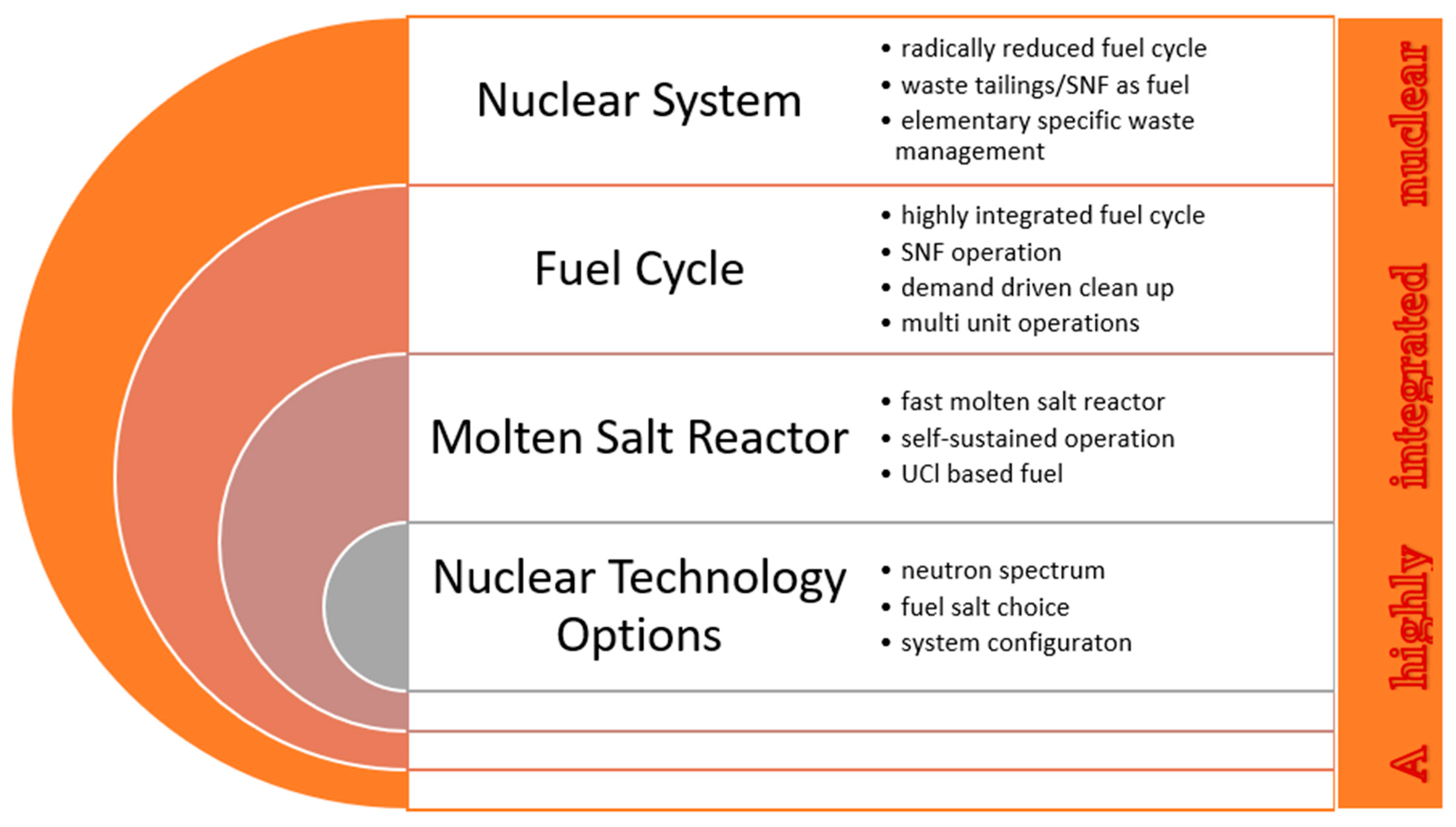
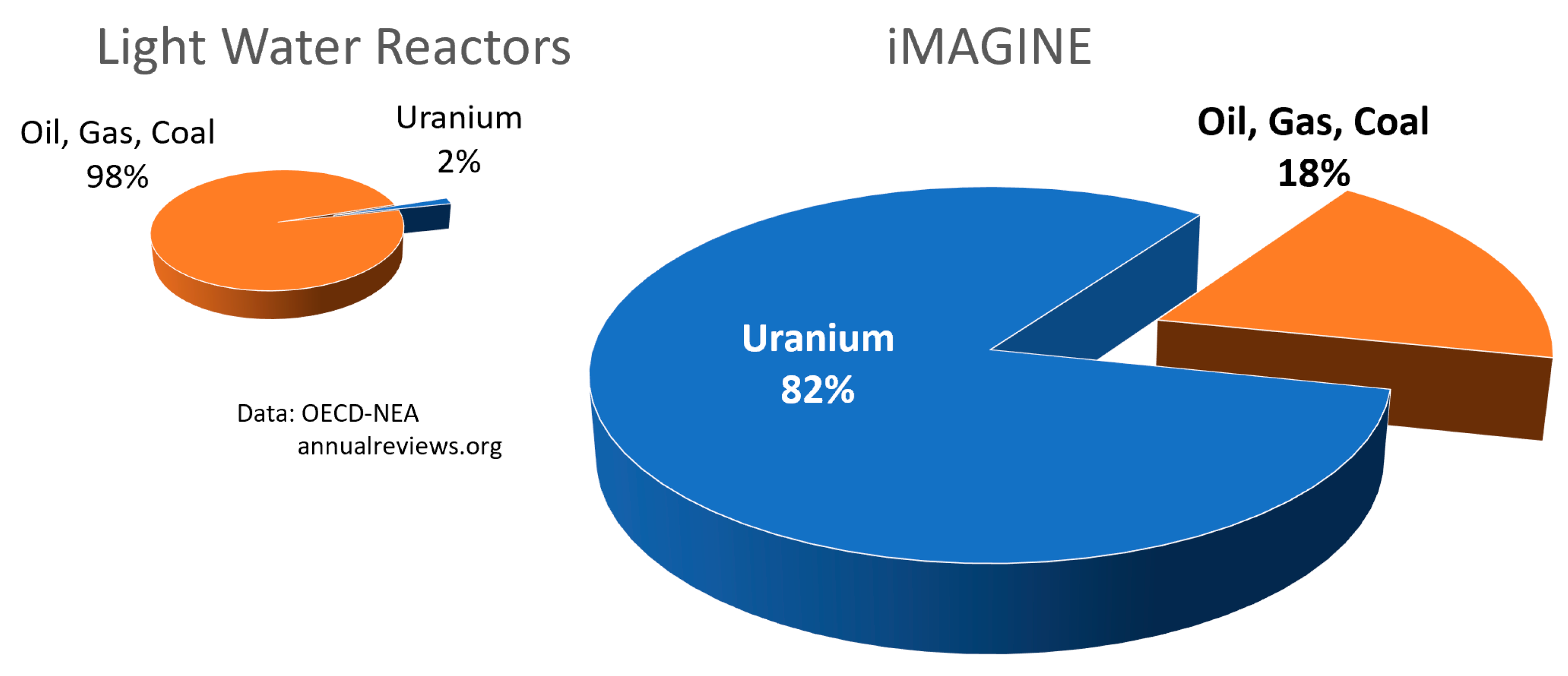
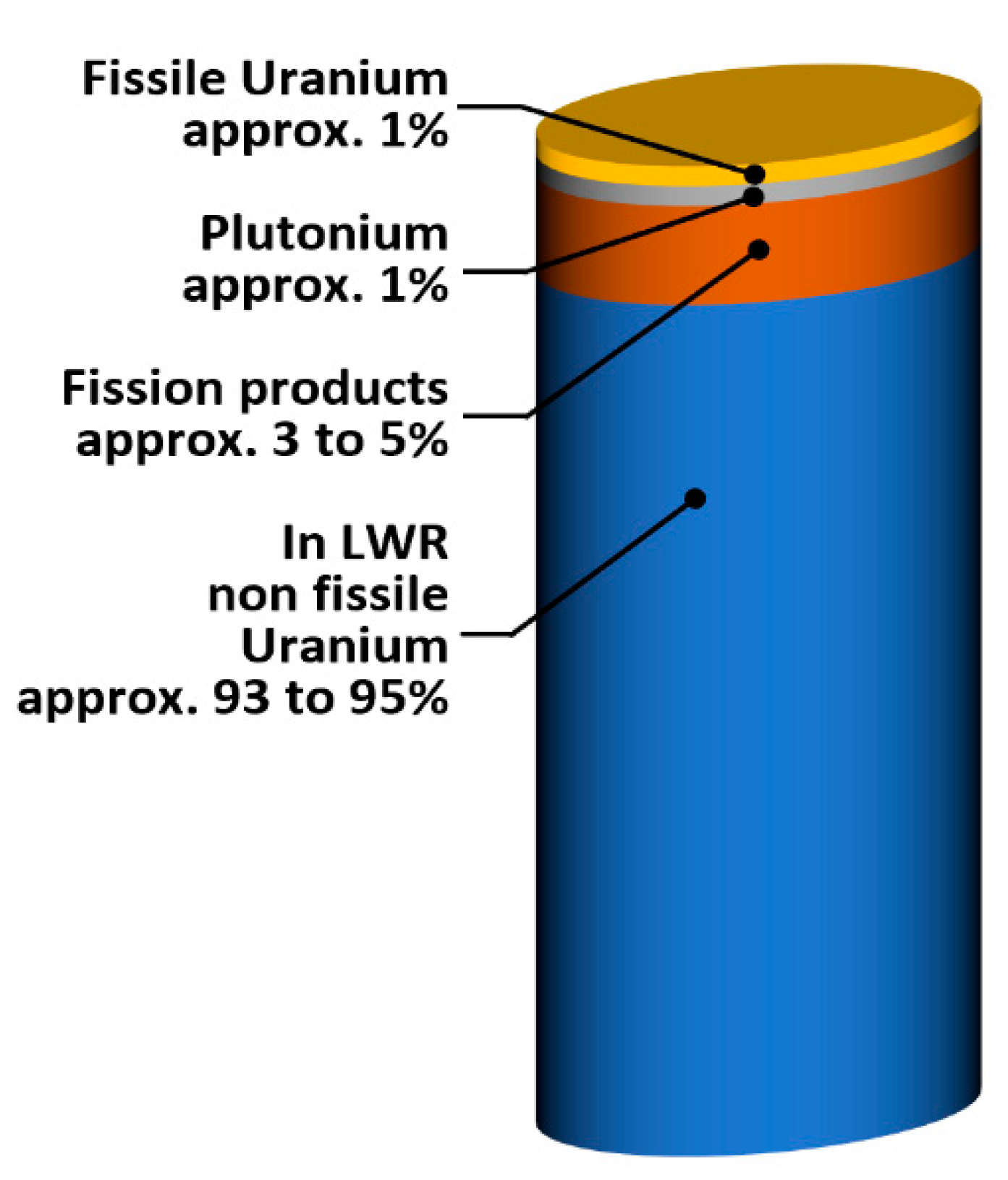
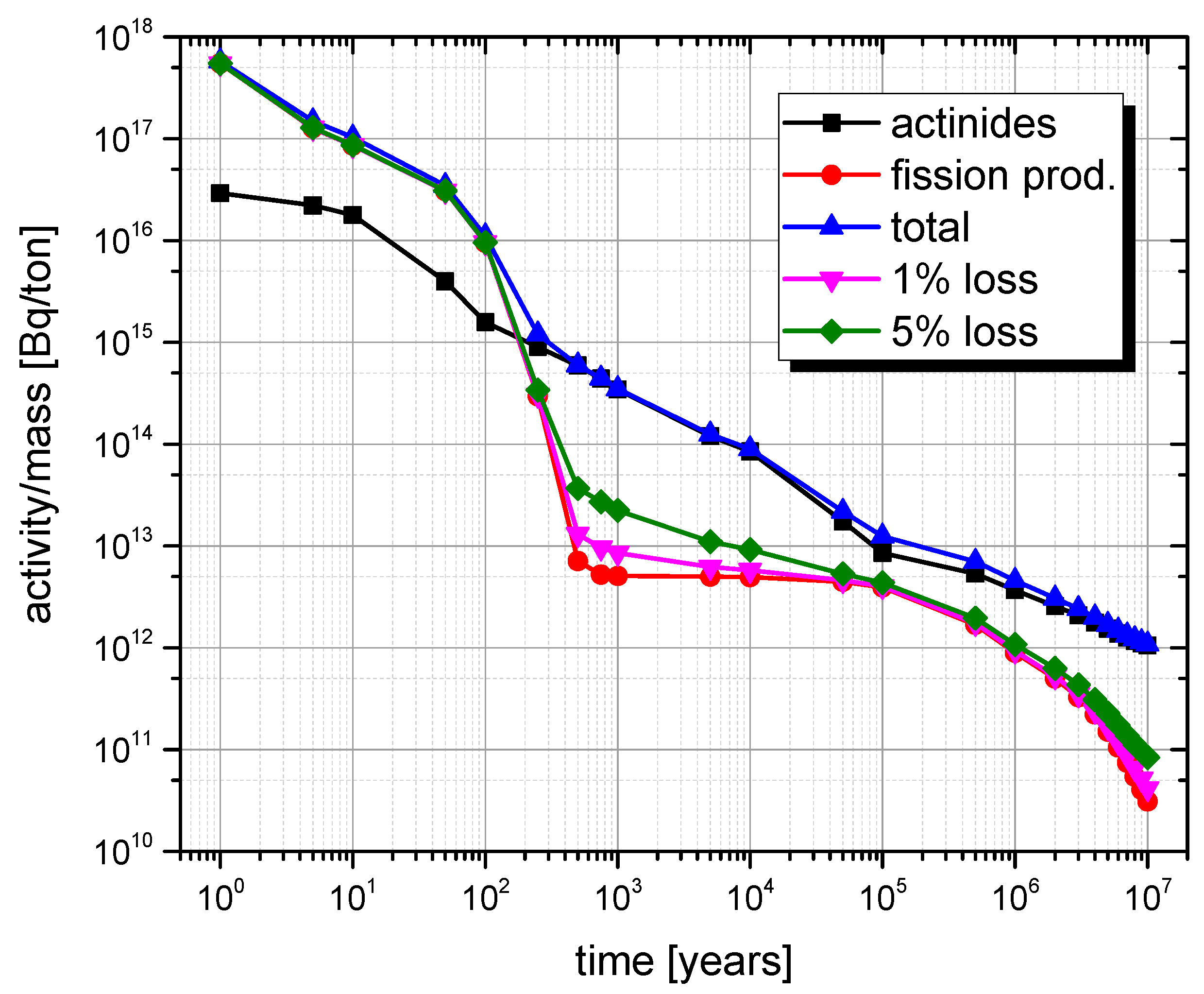
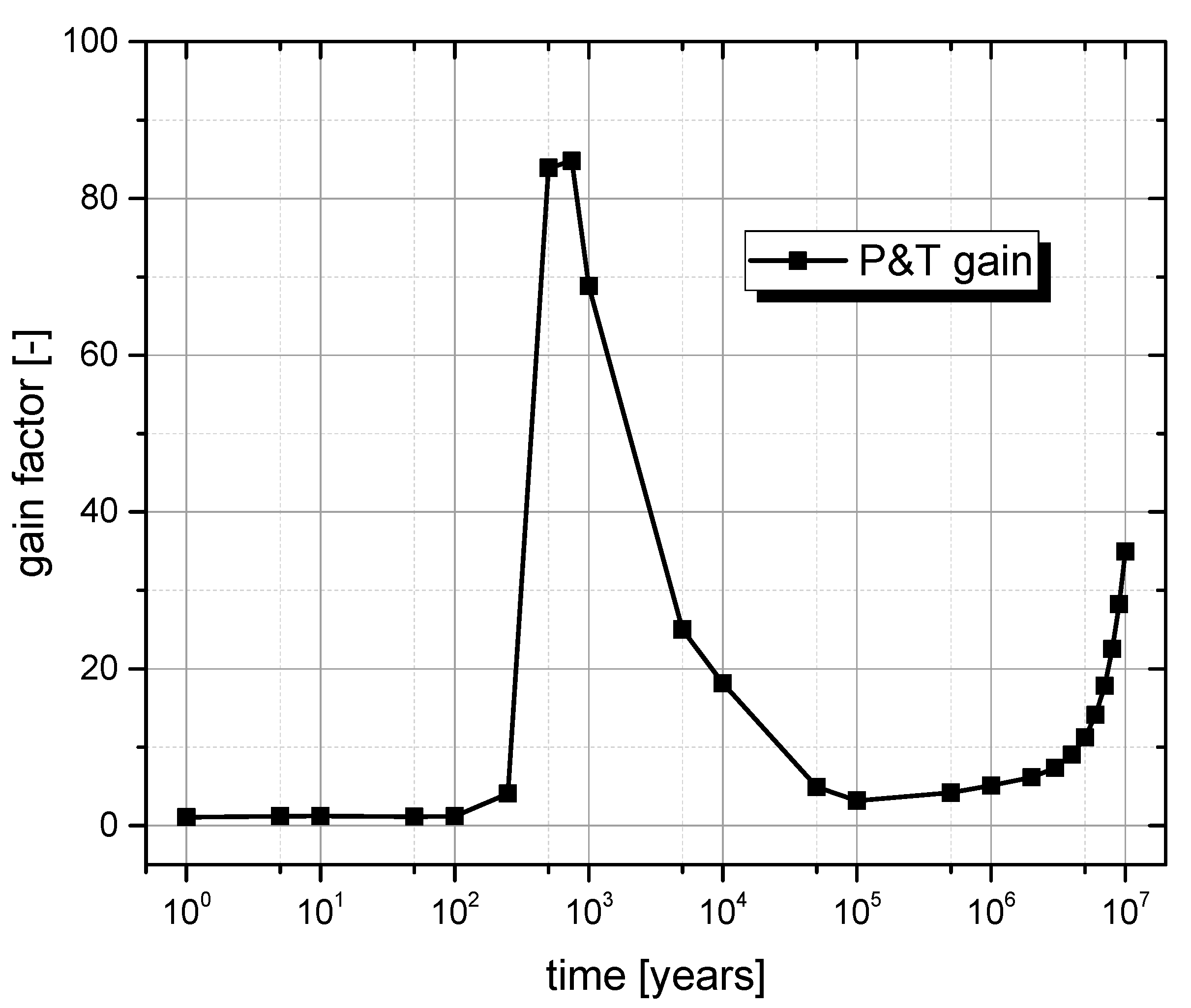
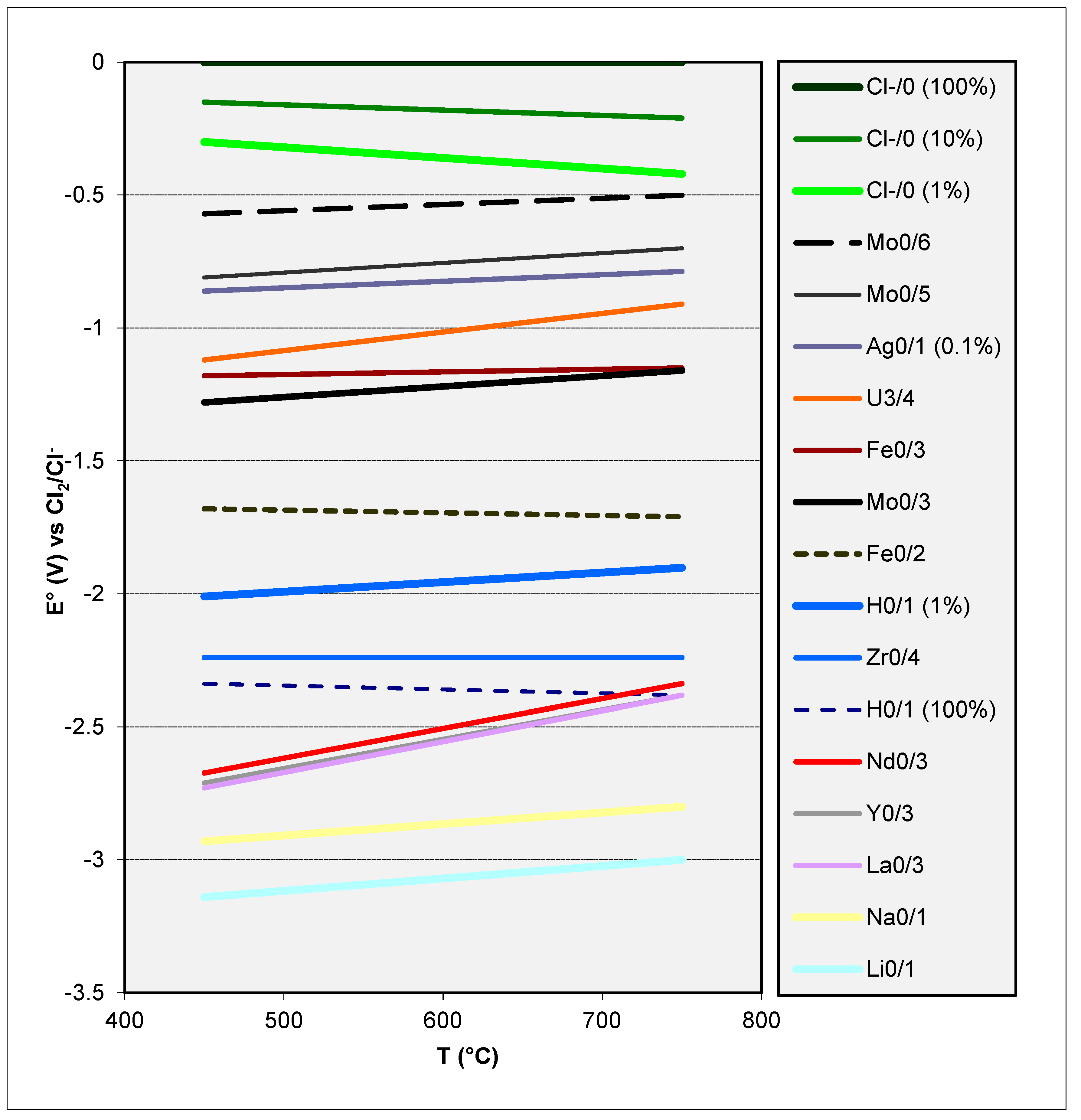
| iMAGINE | LWR | |
|---|---|---|
| Fuel usage | 100 kg from existing sources such as SNF or tailings transformed into uranium chloride | 2500 kg in the form of UOX pellets in fuel assemblies |
| Using up already extracted/mined materials | Made from 20 to 25 tons of natural uranium through enrichment | |
| separated from 28,500 to 72,000 tons of mined material | ||
| Waste production | 100 kg of fission products to be separated through new processes to ensure long-term operation Opportunity to optimally condition separate elements to limit mobility | 2500 kg spent fuel in fuel assemblies containing TRU elements required to be stored and later disposed in a deep geological repository |
| ~20 tons of tailings, which have to be stored | ||
| 28,500 to 72,000 tons of mined material with low activity, creating a major source of radiotoxicity to the environment |
| Time Period (Ears) | Activity Reduction Factor |
|---|---|
| 1-500 with P&T | 81,036 |
| 1-500 without P&T | 966 |
| 500 gain P&T | 84 |
| 500-1 mio with P&T | 8 |
| 500-1 mio without P&T | 131 |
| 1 mio gain P&T | 5.1 |
| 500-10 mio with P&T | 230 |
| 500-10 mio without P&T | 552 |
| 10 mio gain P&T | 35 |
| Categories of Activation and Fission Products | Elements | Concentration (ppm) | Percentage Fraction of the Activation and Fission Products |
|---|---|---|---|
| Top Five | Zr | 4526 | 13.1 |
| Mo | 3934 | 11.4 | |
| Xe | 3736 | 10.8 | |
| Nd | 3155 | 9.11 | |
| Cs | 3093 | 8.93 | |
| Top four rarest elements | Ru | 2562 | 7.40 |
| Pd | 1184 | 3.42 | |
| Rh | 705 | 2.03 | |
| Te | 425 | 1.23 | |
| Noble gases | Xe | 3736 | 10.8 |
| Kr | 497 | 1.43 | |
| Ar | 217 | 0.63 | |
| He | 145 | 0.42 | |
| Ne | 3 | 0.01 | |
| Lanthanides above 1 ppm | Nd | 3155 | 9.11 |
| Ce | 1979 | 5.71 | |
| La | 1010 | 2.92 | |
| Pr | 913 | 2.63 | |
| Sm | 924 | 1.98 | |
| Y | 600 | 1.73 | |
| Pm | 89 | 0.26 | |
| Eu | 56 | 0.16 | |
| Gd | 33 | 0.1 | |
| Tb | 1.35 | 0.004 | |
| Dy | 0.96 | 0.003 | |
| Other notable elements above 1 ppm | Ba | 1336 | 3.86 |
| Sr | 1072 | 3.10 | |
| Tc | 900 | 2.60 | |
| Hx | 657 | 1.90 | |
| Rb | 473 | 1.37 | |
| I | 182 | 0.53 | |
| S * | 99 | 0.29 | |
| Se | 79 | 0.23 | |
| Ag | 74 | 0.21 | |
| Cd | 60 | 0.173 | |
| Sn | 58 | 0.167 | |
| Sb | 15 | 0.04 | |
| Nb | 9 | 0.03 | |
| In | 5 | 0.015 | |
| Ge | 1 | 0.003 |
Publisher’s Note: MDPI stays neutral with regard to jurisdictional claims in published maps and institutional affiliations. |
© 2022 by the authors. Licensee MDPI, Basel, Switzerland. This article is an open access article distributed under the terms and conditions of the Creative Commons Attribution (CC BY) license (https://creativecommons.org/licenses/by/4.0/).
Share and Cite
Merk, B.; Detkina, A.; Litskevich, D.; Patel, M.; Noori-kalkhoran, O.; Cartland-Glover, G.; Efremova, O.; Bankhead, M.; Degueldre, C. A First Step towards Zero Nuclear Waste—Advanced Strategic Thinking in Light of iMAGINE. Energies 2022, 15, 7209. https://doi.org/10.3390/en15197209
Merk B, Detkina A, Litskevich D, Patel M, Noori-kalkhoran O, Cartland-Glover G, Efremova O, Bankhead M, Degueldre C. A First Step towards Zero Nuclear Waste—Advanced Strategic Thinking in Light of iMAGINE. Energies. 2022; 15(19):7209. https://doi.org/10.3390/en15197209
Chicago/Turabian StyleMerk, Bruno, Anna Detkina, Dzianis Litskevich, Maulik Patel, Omid Noori-kalkhoran, Gregory Cartland-Glover, Olga Efremova, Mark Bankhead, and Claude Degueldre. 2022. "A First Step towards Zero Nuclear Waste—Advanced Strategic Thinking in Light of iMAGINE" Energies 15, no. 19: 7209. https://doi.org/10.3390/en15197209
APA StyleMerk, B., Detkina, A., Litskevich, D., Patel, M., Noori-kalkhoran, O., Cartland-Glover, G., Efremova, O., Bankhead, M., & Degueldre, C. (2022). A First Step towards Zero Nuclear Waste—Advanced Strategic Thinking in Light of iMAGINE. Energies, 15(19), 7209. https://doi.org/10.3390/en15197209







